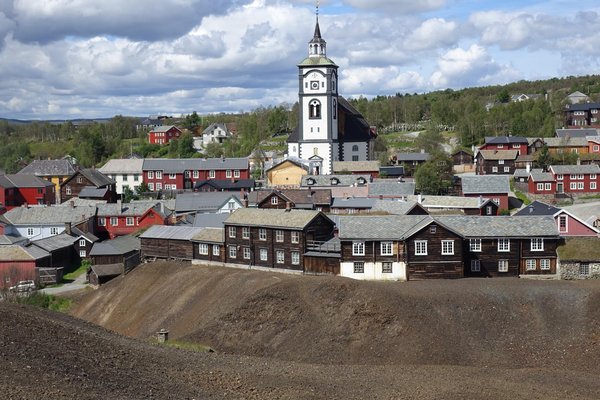Norway
Røros
Røros Mining Town and the Circumference comprises a relict mining town and industrial landscape shaped by copper mining.
Within the Circumference, a privileged area within a 45km radius around town, Røros Copper Works held the monopoly to exploit the natural and human resources. The workers lived in Røros Town, which was fully made of wood. Work was done under severe climatic conditions, and ways were found to adapt to it, for example, via the 'Winter Transport Route' on frozen lakes and rivers.
Community Perspective: this is still a fairly remote site and on public transport, you will not be able to see the outlying components (no reviewer so far seems to have visited by private car). Els describes what a guided tour of the town entails and there are tantalizing videos by André and Joel. Be aware that in summer, the site can get very busy with Norwegian daytrippers.
Site Info
Official Information
- Full Name
- Røros Mining Town and the Circumference (ID: 55)
- Country
- Norway
- Status
-
Inscribed 1980
Site history
History of Røros
- 2010: Extended
- To include the Circumference (the area of privileges awarded by the Danish-Norwegian King to Røros Copper Works in 1646): Femundshytta and The Winter Transport Route.
- 2006: Name change
- From "Røros" to "Røros Mining Town"
- 1980: Inscribed
- Inscribed
- 1979: Deferred
- Bureau - More info required
- Type
- Cultural
- Criteria
- iii
- iv
- v
Links
- UNESCO
- whc.unesco.org
- Official
-
- worldheritageroros.no — Røros World Heritage Site
- Related
-
- rorosmuseet.no — Roros Museum
- visitnorway.com — Visit Roros
All Links
UNESCO.org
- whc.unesco.org — whc.unesco.org/
Official Website
- worldheritageroros.no — Røros World Heritage Site
Related Resources
- rorosmuseet.no — Roros Museum
- visitnorway.com — Visit Roros
Community Information
- Community Category
- Urban landscape: Post-medieval European
- Secular structure: Mines
Travel Information
Recent Connections
-
Full White Nights
-
Depicted in Mizielinska Maps
TownSee i.pinimg.com
-
Extended
2010: To include the Circumference (the…
Connections of Røros
- Geography
- Trivia
- Architecture
-
-
Wooden architecture
-
Baroque
The Baroque church with its white-washed walls (AB ev extension)
-
- Damaged
-
-
Destroyed during invasion
Røros was burned to the ground in 1678 and 1679 by the Swedish Army during the Scanian War.
-
- World Heritage Process
-
-
Extended
2010: To include the Circumference (the area of privileges awarded by the Danish-Norwegian King to Røros Copper Works in 1646): Femundshytta and The Winter Transport Route. -
Cultural landscape not recognized
Clearly descr as a CL in 2010 extension
-
- Human Activity
-
-
Company town
Røros was a ‘company town’ and the copper works were responsible for work, transport, and food supplies, schools, and a few social services. (AB ev extension) -
Copper production
-
- Timeline
-
-
Built in the 17th century
established in 1646
-
- Science and Technology
-
-
Mines which can be visited underground
Olav's MineSee rorosmuseet.no
-
Steam technology
The King’s Mine was the first copper mine to be equipped with a waterwheel and power transmission rods for mining operations; a steam engine was installed in 1841. (AB ev)
-
- WHS Names
-
-
Name changes
Mining town added 2006
-
News
No news.
Recent Visitors
Visitors of Røros
- Adam Hancock
- Alexander Lehmann
- alicemears
- Argo
- Astraftis
- Atila Ege
- Bin
- Birgitte Sørensen
- Cezar Grozavu
- Christer Sundberg
- Claire Bradshaw
- Dan Pettigrew
- Dimitar Krastev
- Elaine McArdle
- Ellen Nielsen
- Els Slots
- Erik Jelinek
- Eva Kisgyorgy
- Fan Yibo
- Farinelli
- Frederik Dawson
- Geert Luiken
- George Gdanski
- GeorgeIng61
- Gernot
- Gjert
- Hadrianus
- HaraldOest
- Harald T.
- henrik_hannfors
- Iain Jackson
- Ingemar Eriksson
- Ivan Rucek
- janem
- Jarek Pokrzywnicki
- Jasam
- JobStopar
- Joel on the Road
- Jonas Hagung
- Jonas Kremer
- Jonas Martinsson
- jonathanfr
- KarenBMoore
- Karito Vies
- Kasia M.
- Knut
- Kurt Lauer
- kutasp
- Laurey
- Laurine
- Loic Pedras
- Luboang
- Luis Filipe Gaspar
- Maciej Gil
- Maja
- Malgorzata Kopczynska
- Marie
- Martin
- Martina Rúčková
- Mikko
- Milan Jirasek
- MMM
- nan
- Nihal Ege
- Olli-Pekka Turunen
- Palimpsesto
- Patrik
- Peter Lööv
- Philipp Leu
- Philipp Peterer
- Ralf Regele
- Randi Thomsen
- Remski
- Roger Enarsson
- Roger Ourset
- Schnitzel
- Sergio Arjona
- Shandos Cleaver
- Slavi
- Solivagant
- Stefan Loov
- Svein Elias
- Szabolcs Mosonyi
- Tamara Ratz
- Tarquinio_Superbo
- Thorben
- Tom Flaten
- Truls Brekke
- Tsunami
- WalGra
- Walter
- Wojciech Fedoruk
- YaroMir
- Zoë Sheng
Community Reviews
Show full reviews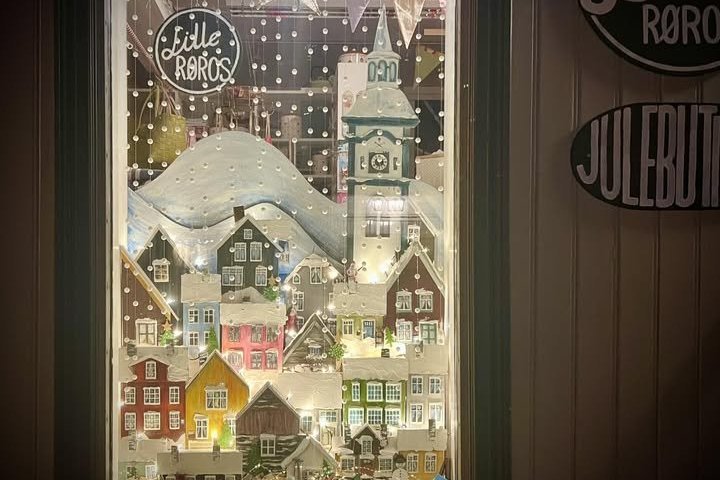
Visiting Røros during the off-season felt like stepping into a forgotten chapter of Norwegian history. The old copper-mining town became almost ghostly quiet when the crowds disappeared. At the heart of the town stood the former copper mining site, its massive mining piles of dark rock forming a miniature mountain that dominated the landscape. Walking up to these piles was a gentle but rewarding climb. From the top, the entire town unfolded below with rows of timber houses, the pastel-painted facades glowing softly in the pale light, and the unmistakable spire of Røros Church rising above the rooftops. Next to the mine piles, we could see the former wooden houses of the workers, some with grass growing on their roofs, and a few almost buried under the piles of rock, silent witnesses to the town’s industrial past. Even though Røros grew from an industrial mining heritage, the feeling it gives today is completely different. Its cozy urban landscape, with friendly proportions and gentle colors, feels inviting and human, remarkably warm even with such a huge pile of dark rocks standing right beside the town.
Beside the mining site ran a small creek that once helped power the copper works. Over time, the stream had been dammed, forming a series of charming waterfalls. The sound of rushing water contrasted beautifully with the stillness of the mine, adding life and movement to an otherwise quiet scene. In the late afternoon light, the water shimmered against the dark stones, reminding us …
Keep reading 2 comments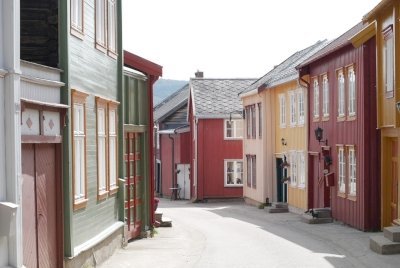
For some surprising reason, the sleepy former mining town of Røros gets 1 Mio visitors each year. When I came, the main road was busy and the parking lot full with caravans and cars. The main street is lined with cafes and shops, as in every other tourist town.
The obvious comparison is with Falun, another mining town in Scandinavia. Falun features a big hole and that is the striking feature of the mine. Røros, meanwhile, is more about the town around the mine, so I think these two sites are distinct. All the colorful wooden houses reminded me more of Rauma than Falun. And I enjoyed my visit significantly more than visiting yet another central European mining town.
The dominating features of the town are the church, the smelting house, the poor worker cottages and the slag heap. The smelting house now houses the Roros museum and is the starting point of guided tours. I would discourage visiting the museum, though, as only one room has been kept in an original state. All other rooms have been repurposed for the exhibition.
Best part to me was just wandering the small streets.
Getting There
As pointed out by Els, the easiest option is to do a day trip from Trondheim. Train leaves Trondheim main station around 9:30 and arrives in Røros at 12:15h. Return trip is at 15:30 or 16:30 depending on the weekday. Be sure to check the schedule for the precise day you …
Keep reading 0 comments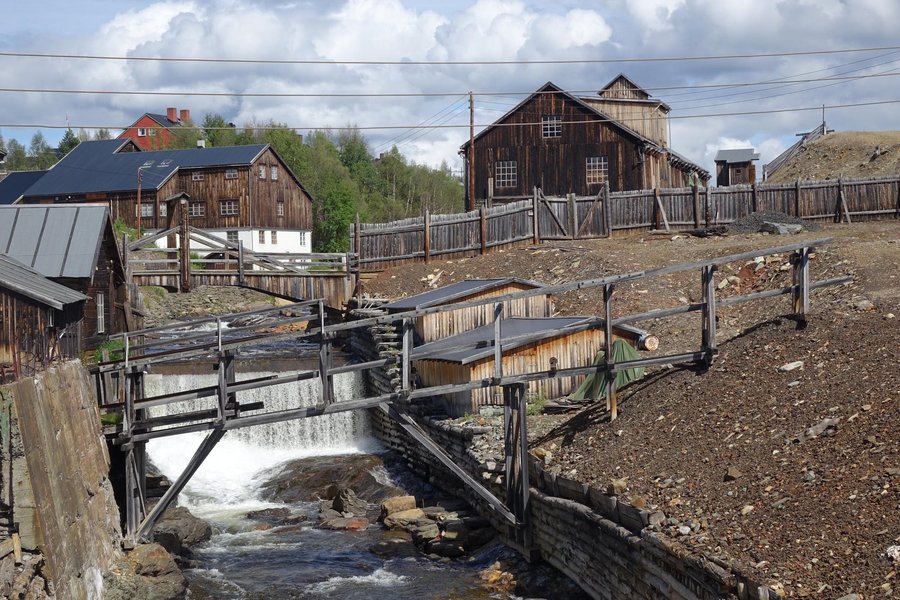
This is another in Norway's collection of slightly oddball World Heritage Sites. It reminded us both of the Copper Mining Town at Falun in Sweden, just across the border (though admittedly Falun was far more developed). It was a surprisingly popular spot for Norwegian tourists, lots of them around enjoying the mid-summer sunshine. Not many internationals though, still too far off the beaten path I guess. My favourite part was the well-preserved old wooden houses in Slag Road, where people lived quite literally in the shadow of the slag heaps. The large "smelting building" is actually a 1980s reconstruction, though admittedly quite well done.
Keep reading 0 comments
Røros wasn’t really what I expected it to be. While preparing for my short visit to this former copper mining town, I discovered that it sees one million visitors yearly. And indeed: upon arrival, it resembled one large parking lot. I also had imagined a mountainous setting, showing the “harsh climatic conditions” the inhabitants had to deal with, which form part of its OUV. At an altitude of 628m, it’s not that extreme. Although it does get pretty cold in the wintertime at this latitude, of course.
I reached Røros by train from Trondheim: there is only one practical departure that allows you to visit it on a day trip (leaving at 9.45, and returning at 16.30). Try to sit on the right side of the train, as it has the best views of rivers and lakes, which are part of the so-called Circumference (the allotted area of privilege to the Røros Copper Works). From the train station, I walked straight to the outskirts of the city, where the Røros Museum is located at the site of the old smelting house. Daily at 1 p.m., an English-language walking tour of the town starts from here. The museum area is the most industrial part that you’ll see in the city, by the way: the actual mines are miles away and not reachable by public transport.
The tour led me and about 10 other tourists first to where the poorest people lived - near the smelting house and the slag heaps. Some …
Keep reading 0 comments
Røros in October 2016, shot with a drone (see link).
Røros Mining Town and the Circumference is linked to the copper mines, established in the 17th century and exploited for 333 years until 1977. The site comprises the Town and its industrial-rural cultural landscapes; Femundshytta, a smelter with its associated area; and the Winter Transport Route. Completely rebuilt after its destruction by Swedish troops in 1679, Røros contains about 2000 wooden one- and two-storey houses and a smelting house. Many of these buildings have preserved their blackened wooden façades, giving the town a medieval appearance. Surrounded by a buffer zone, coincident with the area of privileges (the Circumference) granted to the mining enterprise by the Danish-Norwegian Crown (1646), the property illustrates the establishment and flourishing of a lasting culture based on copper mining in a remote region with a harsh climate.
Keep reading 0 comments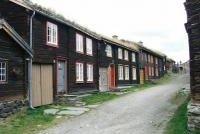
I visited Roros on a day trip by train from Trondheim. The train journey involved a steep climb, with a substantial drop in temperature, even in August.
The town was compact enough to visit all the significant features like the smelting area, slag heaps and workers' cottages on foot, interspersed with visits to the several hot soup kitchens available.
The construction of the houses was of great interest to me, with the walls made from rough hewn logs with interlocking joints at the corners and grass growing in a layer of topsoil on top of the shingle roofs.
Keep reading 0 comments
